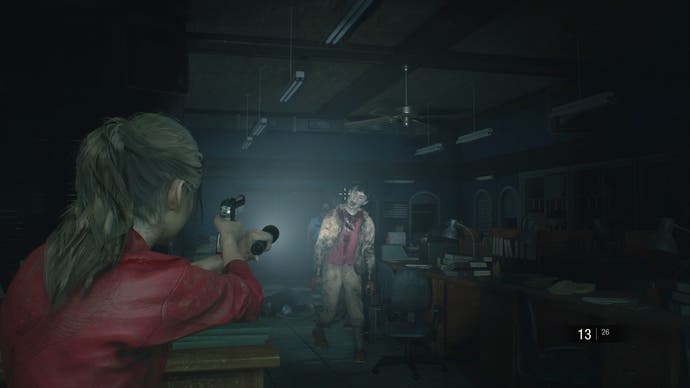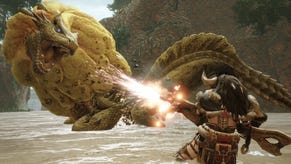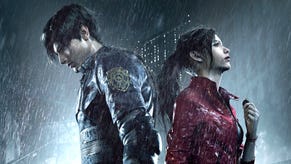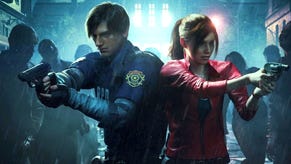Resident Evil 2 review - a masterly reimagining of a modern classic
Raccoon tale.
You know you're playing a good Resident Evil game when you need to keep a pen and a piece of scrap paper close at hand. Sitting on the first open page of my notepad, in a frantic scrawl, are rudimentary diagrams with numbers sticking out at odd angles, repeating three letter codes, bizarre rune patterns, abbreviated riddles, safe-cracking combinations, random running tallies, and then sometimes just the odd word, number or phrase followed with a bemused question mark. Lion statue? Stained glass? Locker room? Keypad? This is the frenzied, stream of consciousness-style note-taking of someone deep down a Resident Evil rabbit hole. As an old-school Resident Evil fan, I couldn't be happier.
Calling this modern Resident Evil 2 a remake feels like an undersell. Yes, it's a faithful recreation of the 1998 survival horror classic, but it has been rebuilt completely from the ground up, resurrecting iconic locations like the Raccoon City Police Station using Resident Evil 7's RE Engine. And the RPD has never looked better. From the detailed character models and animations to the way your quivering torchlight illuminates the glistening entrails of what used to be a cop, this game looks incredible.
Certain elements of the art museum-turned-police station have been reshuffled and reimagined to make sense in a photorealistic environment and for a modern audience, but though this is not the police station as it was in the original Resident Evil 2, it's the police station as you remember it. A grand gilded entrance hall making way for a dozen twisted corridors and antechambers, layered and meted out through keys and trinkets that only get more bizarre as the story continues. The zombies and the corporate espionage are all well and good, but the original game was memorable in a good part due to the station's starring role as both your place of refuge and your prison.
Despite the change from fixed camera angles to a third-person over the shoulder perspective, it's a testament to the layout that locations still manage to be both claustrophobic and oppressive. Even the larger, more open spaces like the main police station reception aren't wasted, as these are often put to use by giving you line of sight to a pursuing enemy as you try to shake them on your way through to another interconnecting hallway. You do get a good feel for where everything is after a few loops around the building, but even veteran players would be lost without the map screen, which mercifully logs all the most pertinent information as you play, including the locations of items you've seen but haven't picked up, safes or lockers you've yet to crack open, windows you've boarded and doors that have yet to be unlocked, along with which key or item you need to open them up.
It's one of the places the game's lineage shines through most and you're going to need to get on board with the micromanagement of it all - regularly casting back to your map screen, flipping through in-game files, opening up your inventory to examine items and find clues as to their usefulness. A feature that very much comes in handy but in hindsight I think I relied upon a little too much is the game's habit of marking a room red on the map when it still has secrets for you to uncover, and blue once you've squeezed it for every last item or ammo clip it's hiding. You can get into a bad habit of constantly flipping back and checking the status of this colour-co-ordination on the map screen instead of simply exploring things at your own pace, but it's also worth bearing in mind that files and various other reading materials are often crucial for seeing Resident Evil's bigger picture, and these do not show up on the map in any shape or form - you just have to keep your eyes peeled for them yourself.
No matter how well you explore, how many enemies you defeat and how many puzzles you solve, however, the game will still have more surprises up its sleeve by the time you first see the credits roll. Upon starting your game of Resident Evil 2, you'll be asked which character you'd like to play as - rookie cop Leon S. Kennedy or obscenely capable college student Claire Redfield. Seeing the campaign through as either one or the other, you'll be meeting unique characters, fighting different enemies and wielding specialist weapons. Upon completing that campaign, you'll be prompted to begin a New Game '2nd Run,' a follow-up scenario featuring the other character where the ending and certain parts of the game have been changed. It's only after completing this second run that you'll get the 'true ending' of the game, and after this second play through you'll also unlock The Fourth Survivor mode and the 2nd Run scenario for your first character.

So, just like the original Resident Evil 2, you can play up to four full length campaigns with varying enemy placements and puzzle solutions every time. The story beats don't vary wildly between first and second run-throughs with the same characters (and the locations don't really vary at all), but there are subtle differences here and there. Combine this with additional challenges to unlock bonus assets and artwork and a hardcore difficulty featuring stronger enemies and the need to use an ink ribbon consumable item to save, means there's plenty to keep classic Resident Evil fans coming back for third or fourth helpings. For reference, it took me roughly seven hours to complete both my first and second campaign, first as Claire and then as Leon. The divergent story paths will take you through pretty much the exact same areas, particularly in the latter half of the game, but Resident Evil 2 makes sure to switch up the gameplay with different weapons, different key item placements and different puzzle solutions. Most situations, in other words, will not be exactly as you first experienced them (except for, oddly, safe code combinations, which carry over wholesale into 2nd run playthroughs).
Both Claire and Leon's scenarios flesh out their individual storylines, but in a new addition to this retelling both Ada Wong and Sherry Birkin are playable for short sections this time around during Leon and Claire's campaigns respectively. Ada's sequence is a little more involved than her playable section in the original game and features a unique hacking gadget that sounds great in theory but isn't all that fun to wield, while Sherry plays an elaborate game of Hide and Seek in a spooky orphanage - as if there's any other kind. These are only very brief detours from the main campaigns they feature in and mechanically, each is very hit and miss in its own way, and yet they both serve as a welcome palate cleanser and quick change of pace to the central campaign.

Playing as Claire and Leon, your time is split between navigating your way around and away from lunging enemies, exercising an itchy, tasty trigger finger when necessary and using your capable yet delicious brains to advance deeper into the city of the dead. As a practiced zombie-killer, I of course know that the fastest way to an efficient kill is with a headshot, but often, even with the most basic fodder in Resident Evil 2, one or even two headshots isn't enough to bring them down permanently. This means that even on standard difficulty, you'll soon find that there are far more enemies than you have bullets, so often you may have to swallow your pride and simply run away. If the zombie is somewhere you'll be passing through with any kind of regularity, however, like a police station thoroughfare, you'll want to at least immobilise them to an extent, by taking off their legs and/or arms.
There's a definite sadistic pleasure to be had in this, too - as satisfying as it is to land a perfect headshot right between the eyes, the act of popping off a zombie's limbs one by one and seeing them fall with a wet slop onto the polished marble floor of the police station reception offers its own grim fun. It's a small act of genius that this game allows you to move and shoot, as you'd expect from any modern third person action title, but in a subtle callback to the game's survival horror roots, shooting is refined this time out in that by standing still for a few seconds, the reticule tightens to a pinpoint and you become far more accurate. It's a way of honouring the series' past without sacrificing the kind of gunplay we're used to in 2019, and this Resident Evil 2 is filled with similar smart tweaks, where things have been refined and reframed, but the spirit of survival horror is left very much intact.
Of course, with some enemies, running is and was always the only option. The Tyrant T-00 (just like in the original, he's never referred to as Mr X in-game) is a formidable foe, but he won't stalk you for the entirety of Resident Evil 2, as some players initially feared. There are certain portions he'll show up for and certainly stress you out during, but this mechanic doesn't outstay its welcome, nor does it definitively block curious players from exploring every inch of the RPD at their own leisure. He's still a horribly imposing and unpredictable presence, though there are moments it does feel unfair that when cornered by him in a dead-end corridor, there's no way to avoid him taking a swing at you other than unloading a couple of bullets into his head to momentarily stun him.
Part of Resident Evil's challenge is weighing up the risk versus reward of travelling back through an infested area knowing full well that you may well end up having to use a healing item or spend more bullets than you can technically afford. That is, of course, part of the game's long-lasting appeal and though this Resident Evil 2 is a beautiful and at times incredibly modern-feeling game, beneath its new and impeccably polished trappings you can still feel the beating heart of the classic and increasingly aged framework it's built on.
But that framework is precisely what made the original Resident Evil 2 such a stone cold classic, and though some story beats have been streamlined and some gameplay mechanics have been embellished or added to, this is a reimagining that sticks remarkably close to its source material. Even better, it toes the line between schlocky and scary that the older Resident Evil games managed so well, and does so in perhaps one of the most atmospheric settings ever to grace a survival horror game. It's good to be back in the RPD. Just be sure to bring a pen and paper with you.












